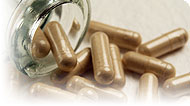Penn Herb Wellness Guide
Folic AcidFind Products

How to Use It
Many doctors recommend that all women who are or who could become pregnant take 400 mcg per day in order to reduce the risk of birth defects. Some doctors also extend this recommendation to other people in an attempt to reduce the risk of heart disease by lowering homocysteine levels. Since the FDA mandated addition of folic acid to grain products, the average intake of folic acid from food has increased in the United States by about 100 mcg per day. However, studies have found that this amount of folic acid is inadequate to maintain normal folate levels in a significant percentage of the groups assessed.1 It now appears that, for pregnant women, supplementing with at least 300 mcg (and optimally 400 mcg) of folic acid per day is sufficient to prevent a folate deficiency, even if dietary intake is low.
Where to Find It
Beans, leafy green vegetables, citrus fruits, beets, wheat germ, and meat are good sources of folic acid.
Possible Deficiencies
Many people consume less than the recommended amount of folic acid. Scientists have found that people with heart disease commonly have elevated blood levels of homocysteine, a laboratory test abnormality often controllable with folic acid supplements. This suggests that many people in Western societies have a mild folic acid deficiency. In fact, it has been suggested that increasing folic acid intake could prevent an estimated 13,500 deaths from cardiovascular diseases each year.2
Folic acid deficiency has also been common in alcoholics, people living at poverty level, those with malabsorption disorders or liver disease (e.g., cirrhosis), and women taking the birth control pill. Recently, elderly people with hearing loss have been reported to be much more likely to be folic acid deficient than healthy elderly people.3 A variety of prescription drugs including cimetidine, antacids, some anticancer drugs, triamterene, sulfasalazine, and anticonvulsants interfere with folic acid.
Deficiency of folic acid can be precipitated by situations wherein the body requires greater than normal amounts of the vitamin, such as pregnancy, infancy, leukemia, exfoliative dermatitis, and diseases that cause the destruction of blood cells.4
The relationship between folic acid and prevention of neural tube defects is partly thought to result from the high incidence of folate deficiency in many societies. To protect against neural tube defects, the U.S. Food and Drug Administration has mandated that some grain products provide supplemental folic acid at a level expected to increase the dietary intake by an average of 100 mcg per day per person. As a result of folic acid added to the food supply, fewer Americans will be depleted compared with the past. In 1999, scientific evidence began to demonstrate that the folic acid added to the U.S. food supply was having positive effects, including a partial lowering of homocysteine levels.5 In the same year, however, a report from the North Carolina Birth Defects Monitoring Program suggested the current level of folic acid fortification has not reduced the incidence of neural-tube defects.6 Many doctors and the Centers for Disease Control in Atlanta7 believe that optimal levels of folic acid intake may still be higher than the amount now being added to food by several hundred micrograms per day. A low blood level of folate has also been associated with an increased risk of miscarriage.8
People with kidney failure have an increased risk of folic acid deficiency.9 Recipients of kidney transplants often have elevated homocysteine levels, which may respond to supplementation with folic acid.10 The usual recommended amount of 400 mcg per day may not be enough for these people, however. Larger amounts (up to 2.4 mg per day) may produce a better outcome, according to one double-blind trial.11
Folate deficiency is more prevalent among elderly African American women than among elderly white women.12
Best Form to Take
Folic acid (vitamin B9) is the synthetic form of folate used in most supplements, and is the most studied form of folate. Some researchers have argued that methylfolate (also known as 5-methyltetrahydrofolate), which is a biologically active form of folate, is preferable to folic acid. However, there is little or no evidence that methylfolate is more effective—and there is some evidence that it is less effective—than folic acid.13
There are some instances where folinic acid—another form of folate—is preferable to folic acid, such as in cases of cerebral folate deficiency, where there is impaired transport of folic acid across the blood-brain barrier.14
Copyright 2025 TraceGains, Inc. All rights reserved.
Learn more about TraceGains, the company.
The information presented by TraceGains is for informational purposes only. It is based on scientific studies (human, animal, or in vitro), clinical experience, or traditional usage as cited in each article. The results reported may not necessarily occur in all individuals. Self-treatment is not recommended for life-threatening conditions that require medical treatment under a doctor's care. For many of the conditions discussed, treatment with prescription or over the counter medication is also available. Consult your doctor, practitioner, and/or pharmacist for any health problem and before using any supplements or before making any changes in prescribed medications. Information expires December 2025.


